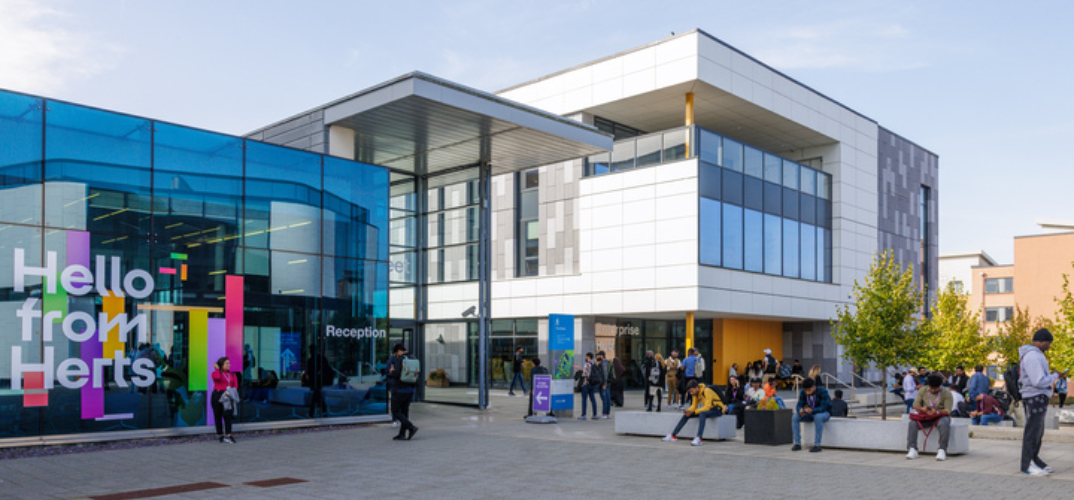New series of access guides designed to support every individual’s accessibility needs launched at Herts

The University of Hertfordshire has teamed up with specialist accessibility company AccessAble to launch a series of Detailed Access Guides aimed at ensuring all visitors to campus can plan their visit with confidence.
The new Detailed Access Guides provide accurate, up-to-date venue access information on buildings, teaching spaces, libraries, sports facilities, accommodation residencies and bus routes across the University’s three sites: College Lane Campus, de Havilland Campus and Bayfordbury Campus.
Each guide contains specific details and photographs to help students, staff and visitors to plan their journey to and around the campus, including information on parking facilities, accessible toilets, step-free access, ramp sizes and weight limits, hearing loops, Braille signage, tactile paving, and walking distances. The guides are designed to assist people with a wide range of needs: for example, detailing colour contrast between areas to aid people with visual impairments and describing building environments to support neurodivergent people.
Ian Grimes, Director of Estates at the University, said: “Our approach to accessibility on our estate has always been both proactive and consultative – we aim to understand our users’ requirements and address them with solutions that meet the widest possible range of needs. Working with AccessAble, who develop the guides using data and feedback provided by their user community, has meant we can do this in a much more comprehensive way. I’m really pleased to see the wide scope and depth of detail in the new guides, and believe they will be an incredibly useful resource to many members of our community.
“Herts prides itself on being a university where everyone, with their individual talents, potential and needs, can thrive. I hope this project will go a step further in making sure our campus is a place where everyone feels welcomed and able to reach their potential.”
Members of the Herts community who have started using the guides have praised the impact they have on day-to-day life on campus. Jill Lees, Learning & Organisational Development Manager at the University, said: “As a member of staff with mobility issues, it is incredibly helpful to have AccessAble as a resource to work out my exact route to rooms and see what the room will be like when I get there – in case it has a step, or I need it laid out in a different manner.”
AccessAble was founded by Herts Law graduate Dr Gregory Burke, inspired by his own experiences as a wheelchair user and disabled walker, and his frustration at the lack of helpful and accurate access information for many places he visited – causing stress, anxiety and isolation.
The organisation now provides access guides to over 70,000 buildings and places across the UK, all comprising detailed and accurate information to meet individual access needs and remove the uncertainty of travelling to new places. The guides are compiled by trained surveyors and are reviewed regularly, and are designed to be living, adjustable and interactive publications that encourage users to provide feedback and corrections to further refine the accuracy of the guide.
David Livermore, Director of Business Development at AccessAble, said:
“We are delighted to launch Detailed Access Guides to the University of Hertfordshire. The university has made a significant investment in accessibility. They’ve worked in partnership with us to ensure detailed access information to the campus is easily available. That is vital for disabled students, visitors, and staff and valuable for everybody.
“Our initiative is all about removing barriers to higher education and improving the experience for everyone. We welcome University of Hertfordshire into our national network of 100+ universities across the country who are committed to including disabled people.”
You can view the University of Hertfordshire Accessibility Guide on the AccessAble website. In future, the University aims to integrate the guides into the Herts Mobile app, giving students and staff access to all the information they need in one place.
Alongside the new AccessAble guides, the University has recently joined the Hidden Disabilities Sunflower, to support members of our community living with a non-visible disability.
Non-visible disabilities are not always visible by looking at or talking to someone. Non-visible disabilities are wide-ranging and can be temporary, situational, or permanent. They can be neurological, cognitive, and neurodevelopmental as well as physical, visual, auditory and including sensory and processing difficulties. They also include respiratory, rare diseases, and chronic conditions such as asthma, diabetes, multiple sclerosis, and Crohn’s disease.
Many people living with a non-visible disability choose to wear a Sunflower lanyard, badge or wristband, as a discreet way for individuals to indicate that they have a non-visible disability and may need additional assistance, kindness, or simply a little more time. Herts is a Sunflower-friendly institution and Sunflower lanyards are now available from the University for staff and students.
Visit the Hidden Disabilities Sunflower website for more information.